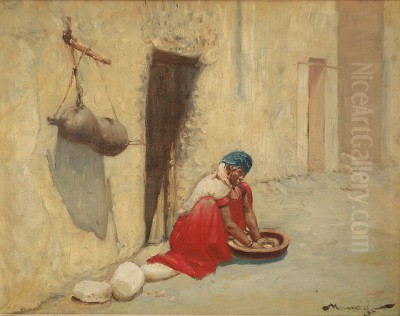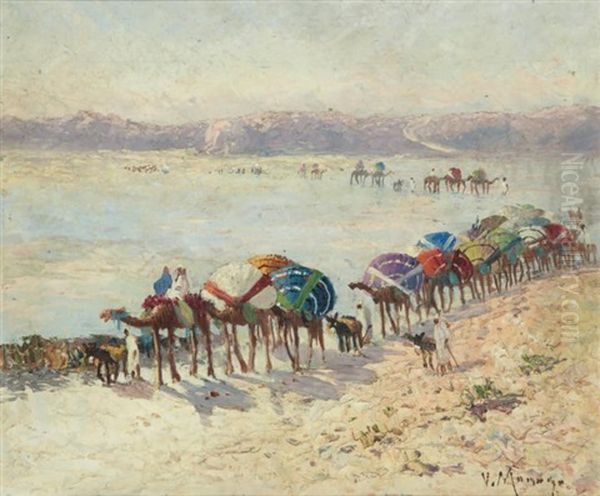
Vincent Manago (1880-1936) stands as a notable figure in early 20th-century French painting, celebrated for his vibrant depictions of Mediterranean landscapes and his engaging Orientalist scenes. Born in Toulouse, France, on January 15, 1880, Manago's artistic journey led him from the south of France to the bustling art world of Paris and across the sea to the sun-drenched lands of North Africa. His work captures the distinct light and atmosphere of these regions, rendered with a characteristic energy and a rich palette that resonated with audiences during his time and continues to attract interest today.
Early Life and Artistic Formation
Manago's formal artistic training took place in Paris, the undisputed center of the art world at the turn of the century. He enrolled at the prestigious Académie Julian, a private art school renowned for its progressive teaching methods and its diverse, international student body. Unlike the more rigid École des Beaux-Arts, the Académie Julian offered a more liberal environment, attracting students eager to explore newer artistic trends. It was here that Manago studied under the tutelage of Jean-Paul Laurens (1838-1921), a respected painter known for his historical and academic works.
Studying under Laurens would have provided Manago with a strong foundation in drawing, composition, and traditional techniques. However, the environment of the Académie Julian, which had previously welcomed artists like Henri Matisse, Pierre Bonnard, and Édouard Vuillard, likely exposed Manago to the swirling currents of Post-Impressionism and the nascent Fauvist movement. This blend of academic grounding and exposure to modernism likely shaped his developing style.
The Magnetism of Marseille and the Mediterranean
Manago developed a strong connection with the south of France, particularly the vibrant port city of Marseille. Between approximately 1900 and 1913, he became a highly popular figure in the city's art scene. Marseille, with its bustling Old Port (Vieux-Port), dramatic coastline (calanques), and intense Mediterranean light, offered a wealth of subject matter that clearly captivated him. His paintings from this period often depict harbor scenes filled with fishing boats, coastal landscapes under bright skies, and the general maritime life of the region.

His success in Marseille was marked by his participation in significant local exhibitions. His works were featured at the Marseille International Exposition and the Colonial Exhibitions focused on Africa and Provence. This visibility cemented his reputation locally and showcased his affinity for capturing the essence of the Provençal coast. The clear light and vivid colours characteristic of the South undoubtedly influenced his palette, pushing him towards brighter and more expressive colour choices, echoing the explorations of earlier artists like Paul Cézanne in nearby Aix-en-Provence, or contemporaries like Paul Signac and Albert Marquet who were also drawn to the light of the Mediterranean coast.
Manago's fascination with coastal life extended beyond Marseille. He is known to have painted scenes in La Rochelle, another important French port city, though on the Atlantic coast, offering a different quality of light and atmosphere. Furthermore, the allure of Venice, a city that has enchanted artists for centuries, also drew him in. His Venetian scenes, such as the work sometimes titled "Vaporetto sur le lac de Venise" (more accurately, Vaporetto on the Venetian Lagoon or Canal), capture the unique interplay of water, architecture, and light in the Italian city, placing him in a long tradition of artists like Canaletto, J.M.W. Turner, and Claude Monet who sought to render its magic.
Journeys into Orientalism
A significant facet of Vincent Manago's oeuvre is his engagement with Orientalism. Like many European artists of the 19th and early 20th centuries, Manago traveled to North Africa, specifically spending time in Tunisia and Algeria. These journeys profoundly impacted his artistic output, providing him with new subjects, exotic atmospheres, and an even greater impetus to use bold, luminous colours. The intense North African light, the vibrant textiles, bustling marketplaces, and scenes of daily life offered a stark contrast to European settings and fueled the Orientalist imagination.
His Orientalist works often depict street scenes, interiors, and figures in traditional attire. He aimed to capture the essence of North African life, sometimes drawing inspiration from readily available sources like postcards, a common practice among artists seeking accessible representations of foreign lands. His painting "Femme arabe preparant un repas" (Arab Woman Preparing a Meal) serves as a prime example of this theme, showcasing his interest in genre scenes from the region. Works like "La Grande Caravane" further highlight his focus on iconic Orientalist subjects.
Manago's approach to Orientalism aligns with a broader European fascination with the 'East', a trend popularized by artists such as Eugène Delacroix in the earlier 19th century and continued by painters like Jean-Léon Gérôme, Frederick Arthur Bridgman, and Étienne Dinet. While Orientalist painting has faced criticism for sometimes perpetuating stereotypes or presenting a romanticized, external view of these cultures, Manago's works are noted for their vibrant energy and decorative quality. He also reportedly undertook commissions to decorate private residences in Tunisia and Algeria, suggesting a direct engagement with the local environment beyond simply easel painting.
Artistic Style: Colour, Light, and Energy
Vincent Manago's style is characterized by its vibrancy and dynamism. He employed a rich and often bold colour palette, using strong contrasts and luminous hues to convey the intense light of the Mediterranean and North Africa. His brushwork can be energetic and expressive, sometimes employing impasto (thickly applied paint) to add texture and presence to his canvases. While grounded in representational painting, his work often pushes towards a more expressive rendering of reality, prioritizing atmosphere and visual impact.
His handling of colour shows an awareness of contemporary trends. Living and working during the height of Post-Impressionism and the explosion of Fauvism (around 1905), Manago's bright palette aligns him with the modern colouristic explorations of artists like Henri Matisse, André Derain, and Raoul Dufy, particularly in their depictions of southern French landscapes. While perhaps not as radical as the leading Fauves, Manago clearly embraced a heightened sense of colour to capture the brilliance of the scenes before him.
His compositions often focus on landscapes, seascapes, and genre scenes. Whether depicting the busy Vieux-Port of Marseille, a quiet canal in Venice, or a sun-baked street in Algiers, Manago demonstrated a talent for capturing the specific character and light of a place. His work balances topographical interest with a lively, painterly execution, making his paintings both descriptive and visually engaging.
Recognition and Legacy
During his active years, particularly the period before World War I, Vincent Manago achieved considerable recognition, especially in the south of France. His popularity in Marseille and his participation in major exhibitions there attest to his standing. His paintings appealed to a public drawn to his sunny depictions of familiar Mediterranean locales and his evocative portrayals of exotic North Africa.
His work continues to be appreciated and appears regularly at auctions, indicating sustained interest from collectors. Paintings like "Port du Sud" (Southern Port) and his Venetian and North African scenes remain popular examples of his output. His works are held in public collections, notably including the Musée de Gray in Haute-Saône, France (likely the institution referred to as the "Graff Museum" in some sources), as well as in numerous private collections worldwide.
While Manago may not have been a revolutionary figure who drastically altered the course of art history like Pablo Picasso or Wassily Kandinsky, he was a skilled and successful painter who made a significant contribution within his chosen fields. He excelled in capturing the unique qualities of Mediterranean light and life, and his Orientalist works add to the rich tapestry of European artistic engagement with North Africa. He stands alongside other respected painters of his era who depicted similar themes, such as Félix Ziem (known for Venice and Constantinople) or Adolphe Monticelli (whose work influenced Van Gogh and who also worked in Marseille).
His legacy also includes his son, Dominique Manago (born 1902), who followed in his father's footsteps and became a painter himself, continuing the family's artistic connection. Vincent Manago passed away in Paris on June 25, 1936, leaving behind a substantial body of work that continues to evoke the sunlit worlds he so vividly portrayed. His paintings serve as a colourful testament to the enduring allure of the Mediterranean coast and the European fascination with the 'Orient' in the early twentieth century. He remains an important figure for those interested in French landscape painting, the Marseille school, and the diverse expressions of Orientalism in art.